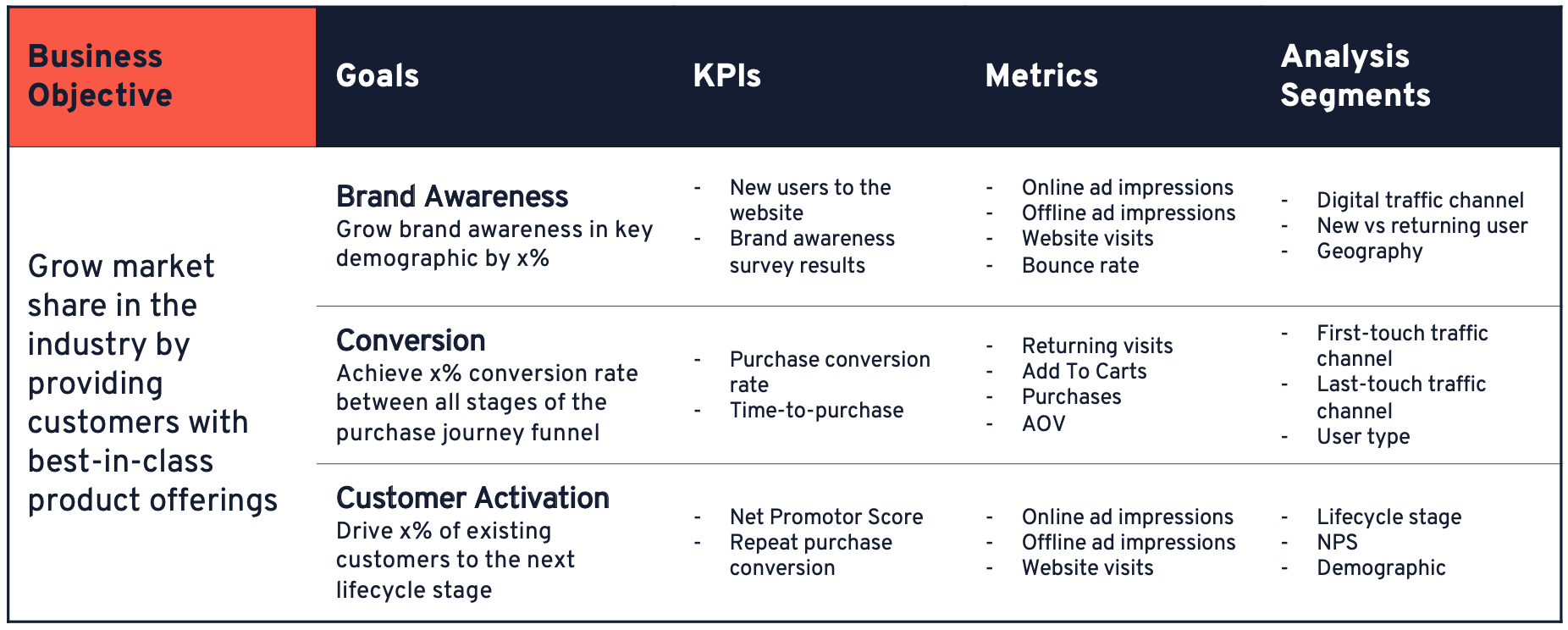Background on measurement strategies

Companies spend around 12% of their overall budget every year on marketing, according to an annual survey from CMO Survey. And every company will no doubt ask: Were our marketing dollars spent successfully? Did our marketing initiatives drive growth for the business? Answering these two essential questions requires data from multiple platforms and many parts of the organization – and it can take months to analyze and report.
That’s why it’s imperative for your company to prepare a marketing measurement strategy on which to ground your measurement. What are your goals? How will you measure them? What are the key drivers of success? Which platforms will you report from? This is a conversation every organization should have among its key stakeholders to determine and document how to define success in marketing.
What is a measurement strategy?
At its core, a measurement strategy is an all-encompassing plan that establishes how business goals will be measured. This strategy follows a path beginning with a top-line business objective, which is then broken down into measurable goals, KPIs, metrics, and finally ways to segment those metrics. It is helpful to organize this information in a grid we call a measurement matrix.

To develop the matrix, we consider these questions:
- Business objective: What is the overall objective of the business?
- Goals: What are the individual goals that ladder up to the business objective? These can be abstract (i.e., increase brand awareness within new demographics) or concrete (i.e., increase new users to the website by 20% each year)
- Key performance indicators (KPIs): What are the actionable, measurable items that indicate success towards your goals? Think of these as the most important metrics with which you inform business decisions
- Metrics: What are the tangible metrics that can be pulled from your analytics platforms and other marketing databases?
- Analysis segments: What are the different ways to divide and analyze the collected metrics – geography, digital traffic channel, demographic, etc. – to nuance performance insights?
Advantages of a measurement strategy
One major advantage of a measurement strategy is a centralized documentation of your organization’s marketing goals. The process of creating a measurement strategy requires looking at your overarching business objective and ensuring that all goals contribute to that objective, as well as all the metrics you are interested in tracking and reporting. The strategy also makes sure everyone is clear on the key performance indicators of success.
From an analytics perspective, the measurement strategy helps guide your technical implementation. Creating this strategy will allow for a more efficient implementation of your tag management system. Instead of using a “catch all” strategy to track every single action on the site, you have already identified key metrics to incorporate into your tag management system. The measurement strategy also drives the conversation around platform connection. Is ROAS (return on ad spend) one of your KPIs? You’ll need to make sure you have a database that stores spend data from all of your marketing platforms as well as revenue from your CRM (customer relationship management). The more all-encompassing your measurement strategy is, the more imperative it is to have a centralized marketing database and well-formed data strategy to support measurement.
Finally, the measurement strategy can help create clear communication between all marketers across your business. By involving all key stakeholders in the development of the strategy and centralizing the documentation, you can be sure your organization is operating against the same objective and goals. Having a written plan that defines the most important metrics can streamline tasks (for example, reporting and determining if a period of time was “successful”), because there is a guideline for what will determine success. While the document itself is valuable, there is significant value in going through the process of creating it, as it establishes clear direction and buy-in from key stakeholders.
Creating your measurement strategy
Best practices dictate that a measurement strategy should be developed prior to any marketing or reporting activities, but as they say: better late than never! If you don’t have a measurement strategy yet, now is a great time to bring together key stakeholders to align on what success looks like for your organization. What are your goals for brand awareness growth? Website engagement? Customer retention? These are the kinds of questions your organization should discuss in relation to all marketing Initiatives.
Photo source: Unsplash



